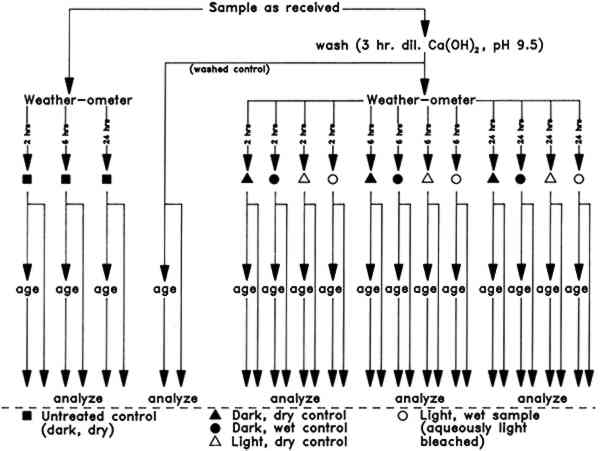EFFECTS OF AQUEOUS LIGHT BLEACHING ON THE SUBSEQUENT AGING OF PAPERTERRY TROSPER SCHAEFFER, MARY T. BAKER, VICTORIA BLYTH-HILL, & DIANNE VAN DER REYDEN
1 INTRODUCTIONThe technique of aqueous light bleaching to diminish stains in paper was first brought to the attention of paper conservators in 1980 by Keyes at the International Conference on Conservation of Library and Archive Materials and the Graphic Arts in Cambridge, England. Simply stated, the technique utilizes exposure to light from the sun (e.g., van der Reyden 1981; Eldridge 1982 or an artificial light source such as fluorescent lamps (e.g., Branchick et al. 1982; Baker 1986), preferably with far ultraviolet radiation removed by filtration, to reduce discoloration in paper while the paper is submerged in a bath of purified and buffered water. Many variations in the procedure have been used, such as the “moisturizing sandwich” (Keyes 1980). However, specific requirements for successful application of aqueous light bleaching have been found to be: prebathing the object, using a buffered or slightly alkaline immersion solution, and restricting treatment to low lignin content paper. Because the procedure is straightforward and an effective tool, many paper conservators have incorporated it into their stain removal repertoire. Their reasons for using this bleaching method are many: (1) It is relatively easy to control; (2) the color of the paper is quite natural after treatment, as opposed to the sometimes overly bright white of chemical bleaching; (3) the paper feels stronger afterward; and (4) the procedure avoids the introduction of another extraneous chemical into an already degraded paper. The chromophores in discolored paper may be degradation products of cellulose or sizing, or they may have been formed by interactions among these chemicals or between them and other inclusions or impurities in the paper, such The possible disadvantages of aqueous light bleaching, which are similar to some of those incurred with other bleaching treatments, are that the absorbed light energy may: (1) cause formation of colored products in the components of the paper; (2) catalyze formation of colorless degradation products in the exposed paper, which may degrade further to colored compounds upon subsequent aging (Burgess 1988); and (3) induce degradation of the paper compounds, which could result in changes in mechanical properties. Several investigators have addressed the above-mentioned possibilities, studying the immediate effects of aqueous light bleaching on the properties of various new and old papers. The surface strength of some papers appears to be increased (van der Reyden 1981), while the tensile strength appears to remain unchanged (van der Reyden et al. 1988); colored substances will appear in some types of papers (Savard 1986); increased efficiency of the treatment may or may not be related to an increase of the pH of the solution(Eldridge 1982); and changes in degree of polymerization (DP) of cellulose after treatment appear to be indetectable (LePage and Perron 1986; Lee et al. n.d.). The effects of the aqueous light bleaching treatment on the subsequent aging of paper have received less attention (Savard 1986; Lienardy and van Damme 1989; Hofmann et al. 1991; Flieder et al. 1991; Lee et al. n.d.). Color reversion will occur, but the extent of this reversion compared to that of aged, unbleached control papers has not always been quantified. The mechanical properties of treated, aged papers have received little unequivocal documentation. Few studies have included aged papers likely to have been used by artists, such as the 1956 protein-sized cotton paper used in this study. An earlier study performed at the Conservation Analytical Laboratory, Smithsonian Institution (CAL) was undertaken to determine to what extent various aspects of an aqueous light-bleaching treatment would affect the color and tensile properties of certain papers (van der Reyden et al. 1988). In these experiments a naturally aged, mixed pulp, alum rosin-sized paper and unsized mixed pulp and cotton linter papers were aqueously light bleached or subjected to various control conditions (e.g., dark immersed or exposed to light while dry) for up to 96 hours in a Weather-ometer. Measurements of paper color before and after treatments showed that the aqueous light bleaching conditions were by far the most effective in removing discoloration from the mixed pulp papers and that the greatest decrease in discoloration occurred in the first 2 hours under these experimental conditions. Interestingly, neither aqueous light bleaching nor dark immersion, even at the elevated temperatures reached in the Weather-ometer, had a significant effect on The aqueous light bleaching research project at CAL has now been extended to include a study of the effects of accelerated aging on color and tensile properties of two papers that represent a modern control paper and a naturally aged artists' paper. As in the previous study, the papers were aqueously light bleached, or subjected to various control conditions, in the Weather-ometer (fig. 1). Physical and chemical properties were monitored before and after the exposures and after artificial, humid oven, aging.
The results of this study, indicate that aqueous light bleaching is an effective method for decreasing discoloration in the papers used and also that less color reversion occurs upon artificial aging of samples which received the aqueous light-bleaching treatment as compared to papers subjected to various control conditions. However, potentially disadvantageous alterations in other properties of the papers did occur. These changes did not appear to be directly attributable to light exposure, although they suggest that further detailed study of the conditions for treatment should be undertaken before aqueous light bleaching can be employed without reservation as a conservation technique. |
